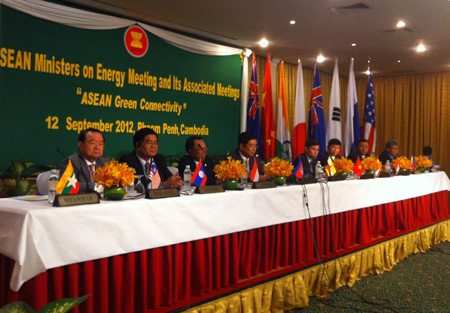
(Photo credit: Agnes Koh, Energy Market Authority)
When ASEAN Energy Ministers met in Phnom Penh last week for their annual meeting, their long-standing concerns of energy security and how to promote greener and more efficient power generation were aired in an open and wide-ranging discussion.
At the end of the 30th ASEAN Ministers on Energy Meeting (AMEM), attended by Singapore's Minister in the Prime Minister's Office and Second Minister for Home Affairs and Trade and Industry, Mr S Iswaran, a statement was issued to highlight ASEAN?s progress to date on energy issues, and to lay out future areas of cooperation.
Between 2005 and 2009, ASEAN countries successfully reduced their energy intensity or how much energy it takes to produce each dollar of a country's GDP by 4.97 percent. This brought them closer to the aim to reduce regional energy intensity by at least 8 percent from 2005 levels, come 2015. But energy consumption looks set to rise by 4.4 percent per year till 2030 under business-as-usual conditions, driven by continued urbanisation and an expanding population.
The ASEAN Ministers agreed that member states would have to double their efforts in ensuring secure, stable, affordable and environmentally-sustainable energy supplies.
Acknowledging the growing presence of natural gas both piped and LNG - in the region's fuel mix, the Ministers noted the progress made in the Trans-ASEAN GAS Pipeline project, which will connect gas-producing/supplying countries to those who purchase gas to generate power. They also tasked senior officials and the ASEAN Council on Petroleum (ASCOPE) to acquire more information about shale gas developments in the US and its potential for LNG exports.
The ASEAN power grid the connection of all national grids so that countries with electricity shortfalls can import from their neighbours - will also be an ongoing area of focus, with efforts stepped up to move the project forward. In the area of energy efficiency, the Ministers welcomed advances in appliances to date that made them consume less energy, but encouraged further progress on clean energy technologies. They noted that there would be a dedicated chapter on ASEAN in the International Energy Agency (IEA) publication "Energy Technology Perspectives 2012", as part of the Clean Technology Development project which ASEAN is pursuing with the IEA.
The role of coal in ASEAN's energy mix also came up. Coal is set to deliver up to 30 percent of the region's energy by 2030, requiring greater focus on the application of clean coal technologies and carbon and capture technology so as to reduce the environmental effects of coal use. The Ministers also asked for greater regional cooperation in coal supply and trading in the event of supply disruptions.
Meanwhile, efforts to promote widespread usage of renewables through hydropower projects as well as workshops on investments in the sector are also set to continue. ASEAN is keen for 15 percent of total installed power capacity to come from renewable sources by 2015.
Mr Iswaran and Cambodia's Minister of Industry, Mines and Energy, Mr Suy Sem, also announced that both countries will strengthen bilateral cooperation in energy. A Cambodian delegation will attend the Singapore International Energy Week (SIEW) 2012 in October and an MOU will be signed highlighting specific initiatives that both countries can cooperate on.